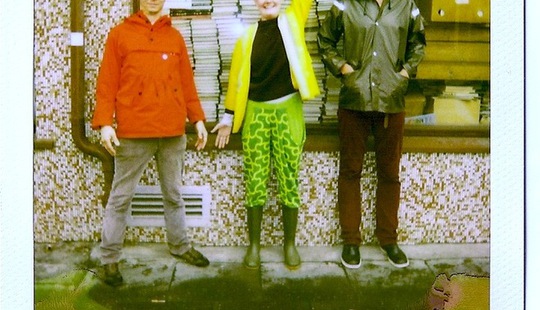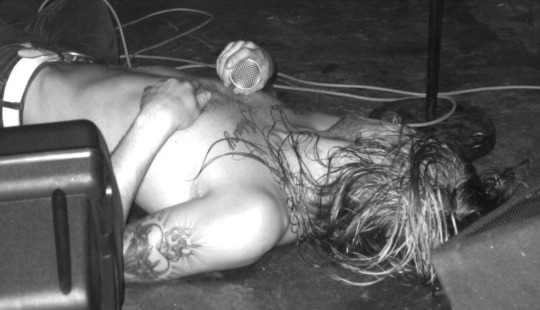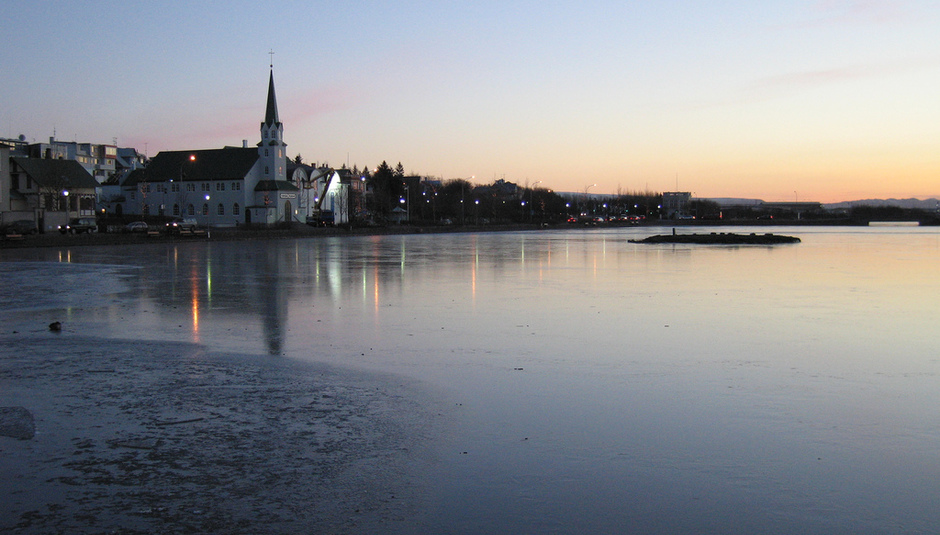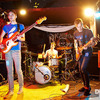As may have briefly been pointed out in other articles we thought - what with Iceland Airwaves being this week and all - that our Nordic Series would be best kicked off with a focus on that very country. It makes perfect sense. So we have tried to do that.
Of course, the primary place in Iceland (for a lot of things) is Reykjavík. There aren't many other places that are all that big. Akureyri isn't so renowned for its music scene although it is, unusually, a place in Iceland that doesn't require any copying-and-pasting of special characters for us with Anglophonic keyboards. Thank Þórr for that! Anyway, who better to write a retrospective of Reykjavík in the 00s than a member of the most excellent band Reykjavík! and editor of The Reykjavík Grapevine? "A Reykjavík Restrospective By Retro Stefson" may have had a marginally better ring to it, but I believe one of their members wasn't even born at the turn of the millennium, so Haukur S. Magnússon it is then!
By Haukur S. Magnússon
This is a pretty big thing you’ve asked me to do, Drowned in Sound, writing a retrospective of the last ten years in Icelandic music for publication in your fine webzine. I care deeply about that scene, and I care double-deeply about how it gets represented (and that it gets represented). I also really like Drowned in Sound as a publication, and would hate to have it feature substandard articles. So I have been anxieting about writing this piece ever since the call came.
I mean, what if I leave something out? What if I don’t really find the time to accurately convey every intricacy of the year 2004 as it really happened. What if I leave something important out? What if I come off like a self-important asshole? What if I fail my deadline! What what what!
I decided to make a timeline, to get me started. Here it is:
2000 – Can’t remember anything about the year 2000. Oh, yes, múm released Yesterday Was Dramatic, Today Is OK
2001 – The first Icelandic hip-hop record is released to great acclaim (XXX Rottweiler’s eponymous debut). Björk releases Vespertine.
2002 – Sigur Rós release the ( ) album. múm release Finally We Are No One
2003 – NOTHING HAPPENED IN 2003!
2004 – Björk releases Medúlla. múm release Summer Make Good.
2005 – Sigur Rós release Takk
2006 – Sigur Rós go around the country to record Heima and Hvarf/Heim
2007 – Sigur Rós release Heima and Hvarf/Heim. Björk releases Volta. múm release Go Go Smear The Poison Ivy
2008 – Sigur Rós release Með suð í eyrum við spilum endalaust. Sigur Rós and Björk play the free ‘Náttúra’ concert.
2009 – múm release Sing Along To Songs You Don’t Know. Sigur Rós release the hounds.
2010 – I get asked to write this thing.
OK. I’m going nowhere, fast. I still have no idea how to convey Iceland’s past decade in terms of music and fun times. I am starting to think someone else might be better suited for the job. Someone who cares less, and was less completely involved and enthralled by the thing. Because – let me tell you – it’s been a blast. I often wonder why I still live here in these dark, negative, bankrupt, post-kreppalyptic times, and then I remember. It’s all the music.

OK. So we start in the year 2000. It was a fine and optimistic year for Icelanders, especially those making or listening to music. Sigur Rós had proven that one needn’t be Björk to gain international recognition for one’s music (múm would go on to do the same thing later that year), and Icelanders all of the sudden had an inkling that there might just be something about this place they were from.
Coming from a small island, a former colony and what used to be the poorest, most downtrodden country in all of Europe (Icelanders like to exaggerate and use lots of exclamations – get used to it if you plan on reading more of this article), it’s real easy to act all humble and feel like you are but a stain on the world map, and Icelanders often feel that way, especially that time when Steve Jobs was presenting some iPhone or other at some Apple conference or other and they just went and left our island off the world map! It just... wasn’t there.
So in the past, Icelanders have been surprised and ecstatic whenever anyone saw reason to acknowledge that the place, indeed, existed, and that there were people living there.
Thus, when people like Sigur Rós and Björk start getting all internationally acclaimed and stuff, when journalists and tourists started showing up looking for ‘cool Iceland’ and all the cool, ethereal music that’s supposedly being made there... then Icelanders get all hyped up and excited and cocky (when an internationally renowned magazine writes: “Iceland is great!” it gets reported on the state news broadcast, and every Icelander is filled with pride and confidence – it works both ways: When UK media writes: “Icelanders are thieves that have no idea how to run a banking system!”, Icelanders get sad and heartbroken and unsure and they feel all rejected and stuff. LIFE IS SO HARD!).
The air was therefore filled with optimism at the dawn of the 21st century. Money was flowing freely due to inflation, and a lot of bands and musicians were making lots of plans to strike it big in the greater world (I do not mean that in a negative sense – except for a few bad apples – folks were generally filled with ambition and they worked real hard). It also didn’t hurt that the Iceland Airwaves festival was up and running at that point, so the local acts that were any good could count on being seen by a somewhat international audience containing A&R guys and music press folks at least once a year. Not a lot of those used to pay Iceland attention. That meant a lot.
As a 19-year-old closely following the Reykjavík scene from my small fishing hamlet of a hometown (it’s called Ísafjörður, it has 3,500 inhabitants), I got real excited about what was going on. There was so much great music out there, so many exciting concerts, so much life. I couldn’t wait to get there. Around that time, you could go out in 101 Reykjavík, grab a copy of the then dominant (and excellent) street mag Undirtónar and figure out whether you wanted to see Apparat Organ Quartet, Maus, Mínus, Quarashi, Vígspá, Botnleðja, Emiliana Torrini, Sigur Rós, múm or Trabant on a given night. Those were the main bands around, and they were all great and exciting in their own ways, and we were all convinced that our music scene was a high quality one (it was).
Time passed and things happened. Bands broke up and bands got started. Having released their début locally on the then-super happening Thule Musik label, múm scored an international distribution deal and started touring abroad. Mínus got people excited about rock 'n' roll again, and Sigur Rós went on to cement their status (while alienating some of their fairweather fans) with the mighty ( ).
While Björk, múm and Sigur Rós were busy representing Icelandic music internationally, Icelandic listeners gravitated towards other sounds. XXX Rottweiler released the first all-in-Icelandic hip-hop record in 2001, and it was nothing short of revelatory for Icelandic audiences. That someone could manipulate our ancient language to work with something as fresh and shiny as hip-hop (we’d had a bunch of English-speaking hip hop, like Quarashi) was astounding. They also had great tunes, confrontational lyrics and that rock ‘n’ roll gang mentality that keeps fascinating people whenever it rears its head.
Their 2001 début sold platinum in Iceland, which spurred an onslaught of Icelandic-language hip-hop that following year. Something like one million (give or take) albums of Icelandic hip-hop were released in 2002, and the progenitors lived like kings and were regulars on TV, radio and magazine covers.
Unfortunately, none of the other records sold (to be honest, most of them sorta sucked), rendering the great wave of Icelandic hip-hop stillborn by all accounts. Hip-hop is still here, though. XXX Rottweiler still play awesome shows and release excellent songs; them and groups like Forgotten Lores have kept the flame going and inspired a younger generation (the kingpin of which is likely Emmjé Gauti – Iceland’s answer to Lil’ Wayne, except he doesn’t do as many drugs. Drugs are really expensive on islands).
2003 was The Year Rock Returned, in a big way. Mínus released their groundbreaking Halldór Laxness LP, which inspired countless Icelandic youths to go around shirtless in cowboy hats shouting mathcore screamo anthems at whoever would listen. Singapore Sling kept the rock vibe floating in 2004, and bands like Brain Police and others kept the ball rolling. Incidentally, that wave of rock was what inspired my fellow philosophy student Bóas and I to found our own band, Reykjavík!, in 2004. All of those bands looked and acted so cool, we felt we had to revolt by forming our own band that would be goofy instead of cool – inclusive instead of exclusive. Y’know. Not handsome and together, but joyous and falling down.
The music scene was bustling with energy. People were talking about it, writing about it and taking part in it. The optimism continued and it seemed absurd that such a small town could foster such a large amount of good-to-great bands. It was a joy to follow, write about and partake in.
The main concert venue at that time was Grand Rokk. They had the great good fortune to have a booking agent working for them (virtually unheard of in Iceland at that time – it still kind of is, except everyone remembers Grand Rokk’s booking agent from the early ‘00s (his name is Freyr Eyjólfsson), who made sure that the bar (a hangout for drunks and bohemia-types on the first floor – concert venue on the second) had quality live music on every night of the week – and that the bands got a sound engineer and some drinks for their troubles. There was a stage, a backstage room and an excellent sound system that provided newcomer bands with a great venue for premiering their skills in a professional environment.
This really was a change for Reykjavík underground musicians. At times, there had even been a pay-to-play policy for bands that weren’t certain to draw a crowd, so getting a soundman, some drinks and the option of charging admittance perhaps helped inspire confidence and vigour within the scene. And it gave a lot of chances to new and upcoming bands.
Grand Rokk kept that pace up until 2006, when the bar was sold to some folks who had the idea of turning it into a sports bar. The sports bar idea never really took off, so in the end all this resulted in was the sound system being stolen bit by bit (they laid off the in-house soundman who had taken care of it), and the booker being laid off. Grand Rokk came back, though, in the late ‘00s, and stayed great for a while. Then it went broke again and closed down for a while. Now it’s called Faktorý, it purports to be a similar venue and I haven’t really had enough experience of it to judge it either way. But those years at Grand Rokk meant a lot, and they were a very useful pump for the Reykjavík music scene (for more info and history on the place, you can read this article I wrote about it when it was supposed to close down in 2006).
So now the year is 2004. Hip-hop still reigns somewhat supreme, although there aren’t a lot of concerts . On the rock side of things, Brain Police, Singapore Sling and Mínus are the main bands. Abroad we have Sigur Rós, múm, Björk, Bang Gang and Gusgus representing us and making some waves (others played abroad too, but they did not make large waves).
I had formed my band Reykjavík! by then (if you’re all into that, you can go to www.reykjaviktheband.com to find out more), and that was incidentally the first time I met anyone from the DiS crew. We in the band were fortunate enough to secure a slot at the Airwaves festival, and were placed on some Thursday night at Grand Rokk, relatively early on (it was thought of as a pretty bad slot, and I do know that Grand Rokk was less packed at that time than at many other times, but it was still an excellent show to play and we were ecstatic to be invited). So we played that show. It was a lot of fun. And then some guys came over and they announced they were from this webzine called Drowned in Sound and they wanted to hang out! We met up with their excellent Gareth Dobson that next day, took turns listening to one another’s iPods and they invited us to come to London to play this Iceland show they were planning. And we’d been playing for like six months or something.

Wow. Huh. I guess that somewhat encapsulates the spirit at the time. The music industry still hadn’t withered completely and stopped signing bands that didn’t already have hits, and cool, snazzy journalists from cool snazzy London webzines like DiS were here. And they were listening! What a time! What a time! I remember, one of my favourite bits from that whole meeting was when Gareth started telling me about this band they had found called “Block Party”. They were apparently really awesome, and he offered to give me a promo of theirs. How nice!
And there were so many great bands around, or in the forming stages. We wound up going to London with the very excellent (now sadly defunct) Skátar, and the equally excellent (still going strong) Skakkamanage and Jan Mayen. These were all new bands at that time, they all had a new and different take on rock music that was less about machismo than what was already there – and these were just four of the ones going round!
Benni Hemm Hemm was also there with his excellent and nostalgic pastoral folk. And somewhere in a garage in Hafnarfjörður, a very young Jakobínarína were practicing to make a total fucking ruckus, storming the UK, being brightest hope and spontaneously combusting all within the space of two years (RIP Jakobínarína 2005 – 2007). Around that time, the aforementioned underground music rag Undirtónar had folded (as well as another free music mag, the very excellent Sánd) and my rag – The Reykjavík Grapevine – was under the helm of one Bart Cameron (he also operated an awesome band in Iceland – The Foghorns) slowly amassing duties as the local paper that covered local bands (even though it was an English speaking one).
Guys. It’s been 2400 words (give or take) and it is now four in the morning where I am. I am wholly unsure if this was the kind of article expected of me by the good people of DiS, and I am furthermore unsure if anyone is excited about Icelandic music to the level of still paying attention at this point. So I’ll leave it at 2005 – half the decade – and if y’all DiS readers and writers and editors want more, e-mail me and I will write a second half. If not, then it’s been an honour to finally get to contribute to the mighty DiS.
Happy birthday, yo!
Haukur S. Magnússon is currently editor for an Icelandic magazine or newspaper (depends on who you ask) called The Reykjavík Grapevine, and he also plays guitar in a band called Reykjavík! (hence the flagrant nepotism – check out our new song Cats on SoundCloud).
He is 29 years old, and he has been reading Drowned in Sound for a long, long time.
Main photo by Rohan Travellin






















